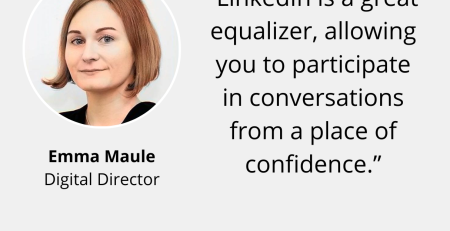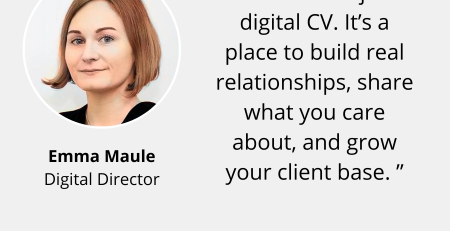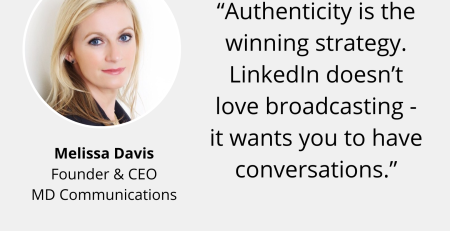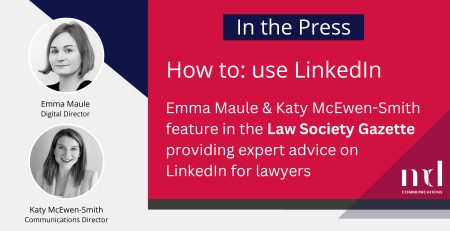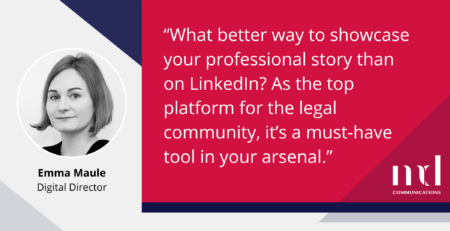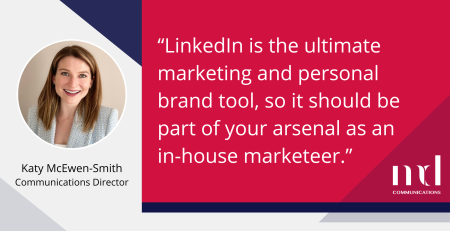Our Digital Director Emma Maule considers what in-house law firm marketing teams can learn from the new algorithm report.
LinkedIn remains the most important platforms for law firms – whether it is job seekers checking out your company page or GCs quietly assessing whether your values align with theirs. But with an ever-changing algorithm and declining organic reach, how can legal marketing teams ensure their firm and its people are presented in the best possible light?
Richard van der Blom’s newly released 251-page report on LinkedIn’s algorithm offers valuable insights – but it’s not exactly light reading. Luckily, we’ve pulled out the most relevant insights for you. Here are the key takeaways for law firm marketers.
Company pages: manage your expectations
Let’s start with the facts:
- Organic reach is down again – to just 2% on mobile and 1% on desktop.
- The majority of users won’t see your content unless someone in their network engages with it.
- In other words, relying solely on your company page is like whispering at a rock concert.
So what can you do?
- Empower your people to be brand advocates: Encourage employees to like, comment on, and share content from the company page to help amplify reach.
- Support individual voices: Encourage team members to post authentic, personal content that reflects their expertise and experiences.
- Gen up on what works: Learn which content pillars and formats perform best to give your page a fighting chance.
Top tips for law firm marketers
What content works best?
A mixture of content pillars plus varying formats is vital to allow your page to thrive. Here are the top content pillars for your page:
- Thought leadership content – reports, articles, even blogs – will gain good reach and also has strong growth and conversion rates.
- Content that puts people first will outperform product-heavy or corporate messaging. This can include personal stories from employees, behind-the-scenes snippets, employer brand content, and customer-generated content.
- Product or service-focused posts tend to perform poorly for reach, but they convert well, so keep them to 5–10% of your content mix. Consider blending them with a human story, personal lesson, or team milestone to encourage more interaction.
Richard also recommends aligning content with industry events, trending news, or key dates and using niche hashtags, as well as tagging relevant people or brands to expand reach.
Mix up your formats
‘One size fits all’ is the wrong strategy here. Ensure you’re posting a mixture of image/s + text, infographics, videos, and carousels (created as a PDF, so added as a document). And don’t forget live steaming – making use of LinkedIn Live will show good results. Note this applies to the video version – LinkedIn seems to be downgrading its audio-only events that were a big thing last year.
Micro-content: small posts, big results
Micro-content refers to short, sharp, scroll-friendly content. This includes posts under 300 characters, visual-only posts (e.g. carousels with minimal copy), and bite-sized video clips. In today’s fast-paced feed, brevity is your friend.
Post formatting
To format a post so it will reach more people, avoid:
- Overusing emojis 🙃
- Too many external fonts – keep these to a few words (e.g. bold/italic via generators)
- Excessive white space – not more than a line between paragraphs
- More than eight hashtags
Instead, combine targeted hashtags with a clear keyword strategy and stick to clean, readable formats that let your message shine. Remember: text only posts are a hard sell, so always include an image, video or carousel if you possibly can.
Newsletters are having a moment
Company page newsletters are seeing a 14% increase in engagement, and they work best when they bring a human angle. Employee stories and career journeys see +45% engagement, while event recaps and behind-the-scenes insights get +25% engagement. However, purely industry-focused content underperforms.
Richard says: “Stop thinking like a brand. Start publishing like a person. Readers want insight with personality, not another press release.”
Avoid external links (mostly)
External links continue to underperform, despite a slight rise in click-throughs (now at 0.75%).
A better alternative is to use images, infographics, or carousels to share key information without a link. These formats consistently outperform posts with external links, as LinkedIn does not want you to leave its platform (a platform-first strategy).
If you really need to include a link, then adding it in the comments is no longer recommended, as LinkedIn will decrease the visibility of comments containing external links. Instead, you have two options:
- Post the content without a link (but with an image), then edit the post to add the link, OR
- Include the link, but remove the preview image it generates and add your own image instead.
Both of these options will give you a similar 20-30% penalty in terms of reach.
Conclusion
LinkedIn is now a mobile-first, platform-first arena. Learn how to format posts that will travel using storytelling and striking visuals, as well as embracing video. Create content that allows humanity and authenticity to shine through by making use of your employees’ contributions.
We offer LinkedIn training for groups and individuals – get in touch if you’re interested.




